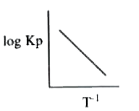Variation of Kp with temperature T is given by for the following cqulibrium 2NH3(g)⇔N2(g)+3H2(g) Thus, decomposition of NH3(g) can be prevented by
 Solution in Telugu
Solution in Telugu
lowering the temperature
Increasing pressure
Isolation of N2(g)andH2(g)
Adding H2(g)
The correct Answer is:A, B, D
Step by step video & image solution for Variation of K_(p) with temperature T is given by for the following cqulibrium 2NH_(3(g)) hArr N_(2(g)) + 3H_(2(g)) Thus, decomposition of NH_(3(g)) can be prevented by by Chemistry experts to help you in doubts & scoring excellent marks in Class 12 exams.
Updated on:21/07/2023Topper's Solved these Questions
- CHEMICAL EQUILIBRIUMBOOK - AAKASH SERIESCHAPTER - CHEMICAL EQUILIBRIUMEXERCISE - ADDITIONAL PRACTICE EXERCISE (LEVEL -II) (LECTURE SHEET (ADVANCED))INTEGER TYPE QUESTIONS
5 Videos
- CHEMICAL EQUILIBRIUMBOOK - AAKASH SERIESCHAPTER - CHEMICAL EQUILIBRIUMEXERCISE - PRACTICE SHEET (ADVANCED)(STRAIGHT OBJECTIVE TYPE QUESTIONS )
20 Videos
- CHEMICAL EQUILIBRIUMBOOK - AAKASH SERIESCHAPTER - CHEMICAL EQUILIBRIUMEXERCISE - ADDITIONAL PRACTICE EXERCISE (LEVEL -II) (LECTURE SHEET (ADVANCED))STRAIGHT OBJECTIVE TYPE QUESTIONS
20 Videos
- CARBOXYLIC ACIDS AND DERIVATIVESBOOK - AAKASH SERIESCHAPTER - CARBOXYLIC ACIDS AND DERIVATIVESEXERCISE - CONVERSIONS
19 Videos
- CHEMICAL KINETCSBOOK - AAKASH SERIESCHAPTER - CHEMICAL KINETCSEXERCISE - EXERCISE - 3.2
45 Videos
Similar Questions
At elevated temperature , PCl5 dissociates as PCI5(a)⇔PCl3(g)+Cl2(g). At 300∘C,mKp=11.8and[PCl3]=[Cl3]=0.01molL−1 at equilibrium [PCl5]=x×10−4molL−1 . What is the value of x ?
View SolutionFor the equilibrium SO2Cl2(g)⇔SO2(g)+Cl2(g) . What is the temperature at which Kp(atm)Kc(M)=3 ?
View Solutionfor the reaction 2A(g)⇔B(g)+3C(g), at a given temperature, Kc = 16. What must be the volume of the falsk, If a mixture of 2 mole cach A, B and C exist in equilibrium ?
View SolutionMethanol to acetic acid
View SolutionDiscuss on the kinetic spontaneity of a chemical reaction. Is a slow reaction spontaneous? Why?
View SolutionFor the reaction, N_(2)(g)+3H_(2)(g) hArr 2NH_(3)(g) , the units of K_(p) are …………
View SolutionFor the reaction
2NH3(g)⇔N2(g)+3H2(g) the units of Kp will be
View SolutionWrite the relation between K_(p) " and " K_(c) for the reaction: N_(2)(g) +3H_(2) (g) hArr 2NH_(3)(g)
View SolutionAssertion: For the 2NH_(3(g))hArr N_(2(g))+3H_(2(g)), the unit of K_(p) will be at. Reason: Unit of K_(p) is (atm)^(Deltan),
View Solutionअभिक्रिया N2(g)+3H2(g)⇔ के लिए 400K पर Kp=41 है। निम्नलिखित में से प्रत्येक अभिक्रिया के लिए समान तापमान पर Kp के मान कि गणना कीजिए - ltbgt (i) 2NH3(g)⇔N2(g)+3H2(g)
(ii) 12N2(g)+32H2(g)⇔NH3(g)
(iii)2N2(g)+6H2(g)⇔4NH3(g)
View Solutionअभिक्रिया N2(g)+3H2(g)⇔2NH3(g) के लिए Kp=Kc(RT) ............
View SolutionDerive the relation between Kp and Kc for the equilibrium reaction.
N2(g)+3H2(g)⇔2NH3(g)
View SolutionK_(p) and K_(p)^(**) are the equilibrium constants of the two reactions, given below (1)/(2)N_(2)(g)+(3)/(2)H_(2)(g)hArr NH_(3)(g) N_(2)(g)+3H_(2)(g)hArr 2NH_(3)(g) Therefore, K_(p) and K_(p)^(**) are related by
View SolutionEquilibrium constant KC for the following reaction at 800 K is, 4 NH3(g)⇔12N2(g)+32H2(g).
The value of Kp for the following reaction will be
N2(g)+3H2(g)⇔2NH3(g)
View Solutionनिम्न अभिक्रियाओं के लिए साम्यवस्था स्थिरांक है
N2+3H2⇔2NH3,K1
N2+O2⇔2NO,K2
H2+12O2⇔H2O,K3
तो निम्न अभिक्रिया के लिए साम्यावस्था स्थिरांक (K) होगा
2NH3+52O2⇐⇒2NO+3H2O
View Solution
